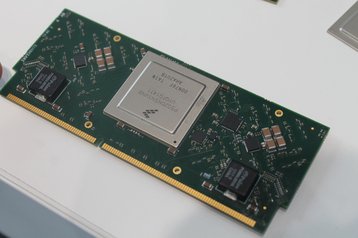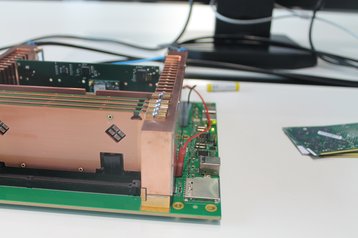IBM and Astron, the Netherlands Institute for Radio Astronomy, are working on microservers cooled with an innovative copper and hot water cooling systems, to process the gigantic amounts of data which will be produced by the Square Kilometer Array (SKA) radio telescope.
The SKA includes arrays of antennas in Southern Africa and Australia, and will be the world’s most sensitive radio telescope when it goes live in 2024. It will gather 14 Exabytes of data each day - of which one petabyte will be significant enough to want to keep, to use in the process of sifting signals from 13 billion years ago, soon after the Big Bang.
Dense, low cost processors
To meet this challenge, the so-called Dome project is proposing a very dense system of low-cost 64-bit processors, packed tightly together and cooled using hot water. It’s the fruits of a €32.9 million project begun in 2012 - which this year showed its progress at the CeBIT show in Hannover. Datacenterdynamics got a walk-through from Andreas Doering of IBM Zurich.
The Dome prototype uses system on a chip (SoC) designs using 64-bit PowerPC processors built by Freescale Semiconductor, combined with memory on small motherboards (133mm by 55mm) which can be mounted very close together to minimize lags in communications between microservers.
Small mother boards
Although the servers use only 35W to 40W, they are packed as tightly as DIMM memory sticks, and need special techniques to remove the heat. IBM and Astron have opted for a copper plate closely coupled to the chip, to remove heat (keeping the OpenPower chip at 85C) and which also delivers electrical power to the chip.
This arrangement, described by Luijten as “electrons in, phonons out”, can be seen in the picture below. The separation between the power and ground is visible towards the bottom of the right hand side of the unit.
At each end of the microserver circuit board, the copper plate gives up its heat to a water circulating system which operates similarly to the hot-water cooling system provided by IBM for the SuperMUC supercomputer in Zurich,
IBM and Astron plan to place 128 microservers - based on the T4240 OpenPower chip - in a 2U rack unit, providing it with 1536 cores and 3072 threads, and 8 Tbyte of RAM.
In June 2014, IBM and Astron promised to develop the technology further in a new European Research Center for Exascale Technology (ERCET) along with the University of Groningen.



